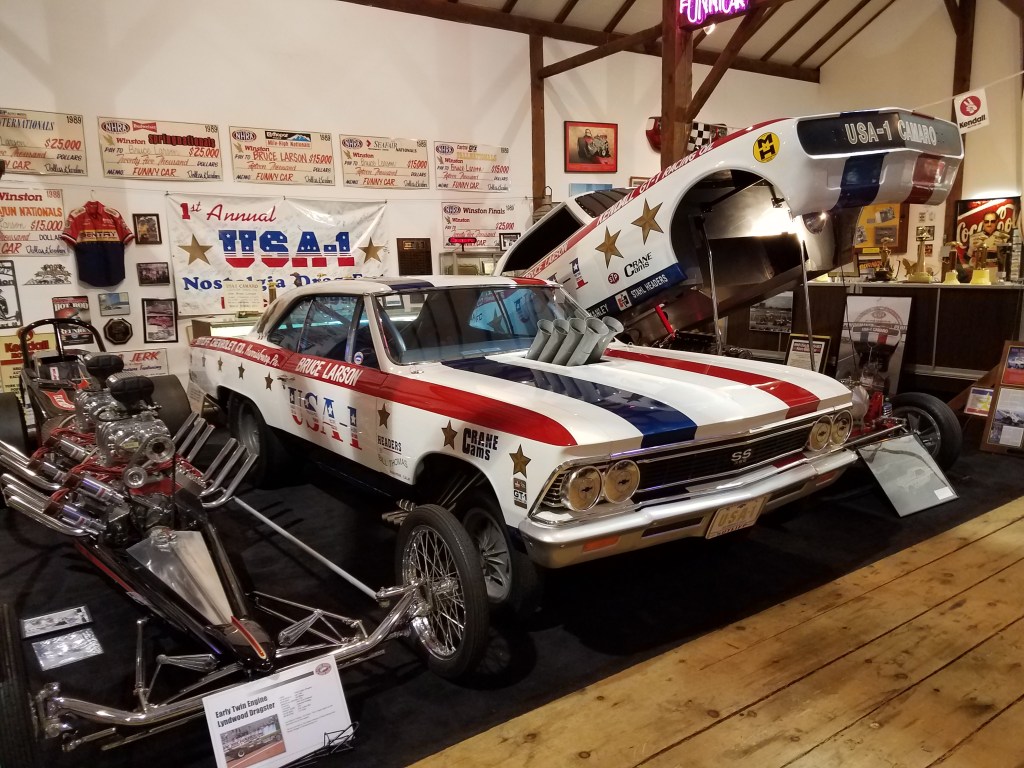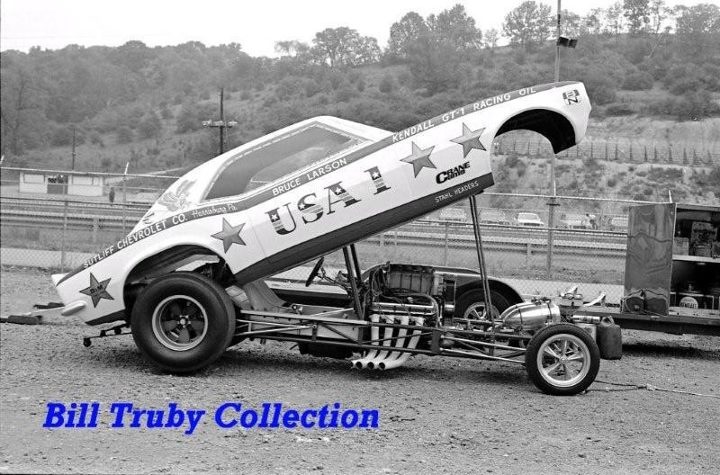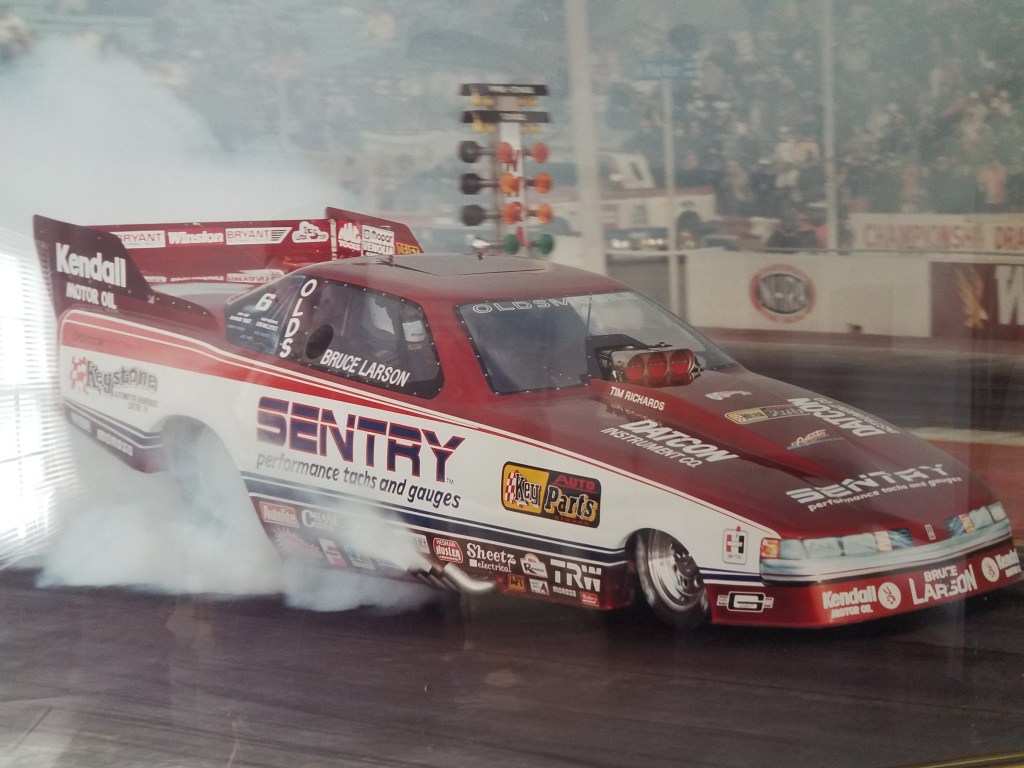Not that long ago, I was at the big annual automotive blowout at Hershey, Pennsylvania, with my friend George Mattar, when both of us were with Hemmings Motor News. We ran into a guy we’re going to discuss in a minute. Just rolled off the truck was the last rear-engine Top Fuel dragster raced by the former child actor Tommy Ivo, fresh off a meticulous restoration. We helped the guy who restored it, Bruce Larson, fire it up for the first time. It was deafening, eye-watering, and all-around delightful. Befitting a legend of East Coast hot rodding and drag racing, Bruce immediately drew a crowd as big as the dragster did. It happens a lot, because Bruce is genuinely a likeable, approachable, truly friendly guy. On the side, he’s made a lot of quarter-mile history. Let’s meet him.

In the long history of drag competition, Bruce goes down as one of the founding fathers of its most popular class, Funny Car, back in the 1960s. He was born in 1937 in Camp Hill, Pennsylvania, across the Susquehanna River from the state capital, Harrisburg, where he became an active street racer while barely past adolescence. At the time, Bruce worked for a local mowing contractor who owned and raced a 1941 Ford with a full-on flathead V-8 for power. Bruce was duly inspired and though only 14 years old, he bought and built up a chopped, fenderless 1932 Ford five-window coupe, crafted to mimic the smooth hot rods coming out of California, and eventually stuffed with Oldsmobile power. In 1954, he took it to Linden, New Jersey, where the first National Hot Rod Association-sanctioned drag race was taking place at a local airfield (it’s still there). Bruce was hooked. He still has the car, by the way, and it, too, has been restored.

He continued racing and in 1965, found himself in a 289-cu.in. Shelby Cobra, running in the NHRA’s AA/Sports Car category. That year, Bruce won three NHRA national events, including the U.S. Nationals at Indianapolis, while taking the national class record away from another Cobra fielded by Carroll Shelby himself. Around that same time, Bruce was working at Sutliff Chevrolet in Harrisburg, whose boss figured (correctly) that being involved in motorsports would help to sell new cars. At the time, the NHRA had a class called Factory Experimental that allowed racers to do all sorts of crazy things to stock-bodied drag cars that weren’t legal in other categories. Sutliff’s entry was an altered-wheelbase 1966 Chevelle motivated by a fuel-injected Chevrolet big-block, but the car had a major difference: It was the first A/FX car in the United States with a full fiberglass body. It became the template for what the NHRA later renamed its Funny Car division. The Chevelle’s in the middle of the next photo, and now is a prominent exhibit at the Don Garlits Museum of Drag Racing in Ocala, Florida.

By this time, Bruce has adopted the name USA-1 for his race cars. After a couple of successful seasons with the Chevelle, the Funny Car was firmly implanted as a new, wildly popular category of drag racing. Technologically, it was evolving rapidly. The hot ticket was to have an all-fiberglass body like the Chevelle, only one that was hinged at the rear, for driver and mechanical access, and located atop a purpose-built tubular steel chassis. The dominant chassis builder in the new class was the Logghe Stamping Company of Detroit. Still with Sutliff backing, Bruce commissioned a new USA-1, with a fiberglass Chevrolet Camaro body atop a Logghe frame. Bruce still has this car, too, which grabbed part of the NHRA national record by running 7.41. The car actually has a functional driver’s door. As Bruce explained, “I wanted a fliptop, but I was a little afraid of fire, and we hadn’t thought about having a roof hatch at the time.” Bruce used this car to score what he considers to be his most rewarding win, at the 1969 Super Stock Nationals held at York U.S. 30 Dragway in Pennsylvania. He bested another Funny Car legend, the late Dick Harrell, to win the race.

A second Camaro-bodied Funny Car followed, which was destroyed in a 1972 fire, something that encouraged Bruce to try his hand at Pro Stock. The Funny Cars still beckoned, and by the mid-1980s, Bruce was back under fliptop fiberglass and running under an alliance with fellow Pennsylvania nitro racer Joe Amato, which produced Bruce’s first NHRA national win in Funny Car. For 1989, Bruce had backing from Oldsmobile and a sponsorship deal with Sentry automotive instruments. He also hired Maynard Yingst, a former Sprint car driver from Pennsylvania, as his crew chief. They won Funny Car first time out at the 1989 NHRA Winternationals, plus five additional national events, an effort that culminated with the NHRA world championship in Funny Car. He was named Funny Car driver of the year by Car Craft magazine. Sadly, Yingst died of a brain aneuyrism in 1993.

Bruce is indisputably one of Funny Car racing’s earliest innovators and brightest stars. He is enshrined in Garlits’ International Drag Racing Hall of Fame, the Eastern Motorsport Press Association (which also presented him with its Al Holbert Memorial Driver of the Year award) Hall of Fame, the Pennsylvania Sports Hall of Fame, and the Super Stock magazine Hall of Fame. He also holds a prestigious award named for another Pennsylvania drag legend, “Jungle Jim” Liberman. The COVID-19 pandemic forced its cancellation this year, but Bruce ordinarily hosts an annual USA-1 Dragfest at his home base in Dauphin, Pennsylvania.
Always enjoyed seeing Bruce at Atco, Englishtown, N.J., Cecil County Maryland and Maple Grove Dragway sine I was a boy at 10 yrs. old in the late 60’s!
LikeLike
I am wondering if Bruce and Jim Costilow ever got back together later in life. I think Costilow owned that Cobra from 1966 era.
LikeLike
Late 1960’s, early 70’s my then boyfriends uncle Ike Peck was a great friend of Bruce. Boyfriend and I got to go with Bruce to Sutliffe And I simply remember being in the follow car to races in Pittsburgh and return
I’m 74 yo now and cannot remember much about him and his wife but they sure were very kind people
LikeLike
I was flickin’ channels yesterday and saw your 1989 championship race Hope all is well with you now! Not painting anymore but still doing a little paintwork at 82′
LikeLike